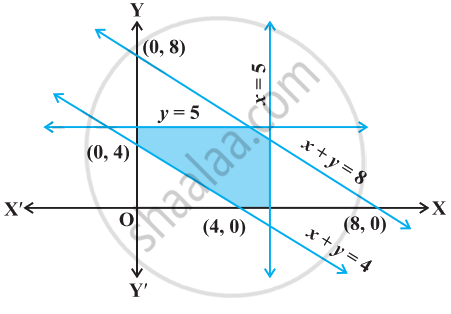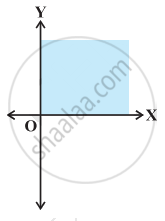Advertisements
Advertisements
Question
Find all pairs of consecutive even positive integers, both of which are larger than 5, such that their sum is less than 23.
Solution
Let x be the smaller even integer. Then, the other even integer shall be x + 2.
Therefore, as per the given condition:
\[x > 5 \text{ and } x + x + 2 < 23\]
\[ \Rightarrow x > 5 \text{ and } 2x + 2 < 23\]
\[ \Rightarrow x > 5 \text{ and } 2x < 21\]
\[ \Rightarrow x > 5 \text{ and } x < \frac{21}{2}\]
\[ \therefore x \in \left\{ 6, 8, 10 \right\}\]
\[\text{ Hence, the pairs are } (6, 8), (8, 10), (10, 12) .\]
APPEARS IN
RELATED QUESTIONS
Solve the following system of inequalities graphically: x ≥ 3, y ≥ 2
Solve the following system of inequalities graphically: x + y≥ 4, 2x – y > 0
Solve the following system of inequalities graphically: 2x – y > 1, x – 2y < –1
Solve the following system of inequalities graphically: x + y ≤ 6, x + y ≥ 4
Solve the following system of inequalities graphically: 2x + y≥ 8, x + 2y ≥ 10
Solve the following system of inequalities graphically: x + y ≤ 9, y > x, x ≥ 0
Solve the following system of inequalities graphically: 5x + 4y ≤ 20, x ≥ 1, y ≥ 2
Solve the following system of inequalities graphically: 3x + 4y ≤ 60, x + 3y ≤ 30, x ≥ 0, y ≥ 0
Solve the following system of inequalities graphically: 2x + y≥ 4, x + y ≤ 3, 2x – 3y ≤ 6
Solve the following system of inequalities graphically: 4x + 3y ≤ 60, y ≥ 2x, x ≥ 3, x, y ≥ 0
Solve the following system of inequalities graphically: 3x + 2y ≤ 150, x + 4y ≤ 80, x ≤ 15, y ≥ 0, x ≥ 0
Solve the following system of inequalities graphically: x + 2y ≤ 10, x + y ≥ 1, x – y ≤ 0, x ≥ 0, y ≥ 0
Find all pairs of consecutive odd positive integers, both of which are smaller than 10, such that their sum is more than 11.
Find all pairs of consecutive odd natural number, both of which are larger than 10, such that their sum is less than 40.
A solution is to be kept between 86° and 95°F. What is the range of temperature in degree Celsius, if the Celsius (C)/ Fahrenheit (F) conversion formula is given by\[F = \frac{9}{5}C + 32\]
The longest side of a triangle is three times the shortest side and third side is 2 cm shorter than the longest side if the perimeter of the triangles at least 61 cm, find the minimum length of the shortest-side.
How many litres of water will have to be added to 1125 litres of the 45% solution of acid so that the resulting mixture will contain more than 25% but less than 30% acid content?
A solution of 8% boric acid is to be diluted by adding a 2% boric acid solution to it. The resulting mixture is to be more than 4% but less than 6% boric acid. If there are 640 litres of the 8% solution, how many litres of 2% solution will have to be added?
The water acidity in a pool is considered normal when the average pH reading of three daily measurements is between 7.2 and 7.8. If the first two pH reading are 7.48 and 7.85, find the range of pH value for the third reading that will result in the acidity level being normal.
Write the set of values of x satisfying the inequation (x2 − 2x + 1) (x − 4) < 0.
Write the solution set of the equation |2 − x| = x − 2.
Write the set of values of x satisfying |x − 1| ≤ 3 and |x − 1| ≥ 1.
Write the number of integral solutions of \[\frac{x + 2}{x^2 + 1} > \frac{1}{2}\]
Solve each of the following system of equations in R.
\[5x - 7 < 3\left( x + 3 \right), 1 - \frac{3x}{2} \geq x - 4\]
Solve the following system of inequalities graphically.
3x + 2y ≤ 12, x ≥ 1, y ≥ 2
Find the linear inequalities for which the shaded region in the given figure is the solution set.
Show that the following system of linear inequalities has no solution x + 2y ≤ 3, 3x + 4y ≥ 12, x ≥ 0, y ≥ 1
Solve the following system of linear inequalities:
3x + 2y ≥ 24, 3x + y ≤ 15, x ≥ 4
Show that the solution set of the following system of linear inequalities is an unbounded region 2x + y ≥ 8, x + 2y ≥ 10, x ≥ 0, y ≥ 0.
Solution set of x ≥ 0 and y ≤ 0 is
